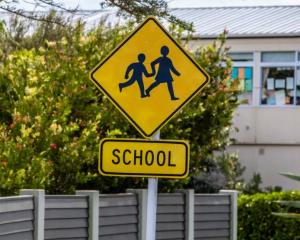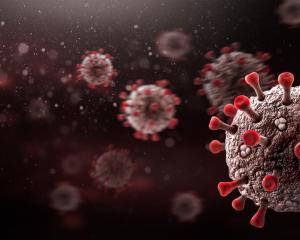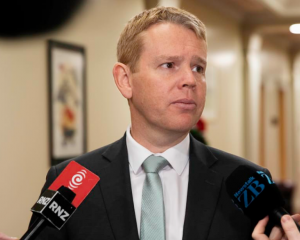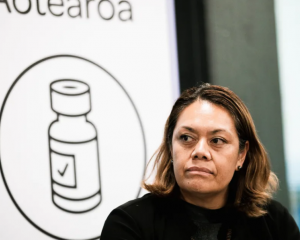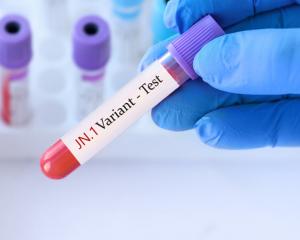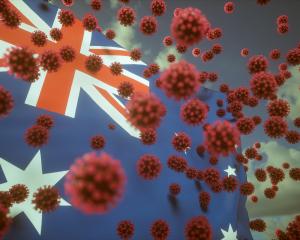Thousands of new cases of Covid-19 are being reported every day in New Zealand, but this is likely to be half of the number of actual cases, Dr Ashley Bloomfield says.
The Director-General of Health today gave an update on the response to Covid and the Omicron variant. It's the first time in a number of weeks a government official or minister has taken the podium since daily news conferences were put on hold in April in favour of statements.
There were 7441 community cases reported today - but Bloomfield said many cases were not being reported.
The Ministry of Health tried to estimate the level of reporting by looking at the positivity rate of the border workers who were undergoing constant surveillance testing, he said.
"Based on that, we think that probably about half of actual cases are being reported. And some of those cases not being reported are because people don't have symptoms ... others the symptoms may be very mild so they don't get tested, whilst others may be testing, but not reporting the result."
With a further 29 deaths with Covid today, Bloomfield said the impact of the severity of Omicron was still visible.
"I mentioned a couple of weeks ago we're also looking at how those deaths are categorised and we're very nearly through that work."
He said death information would be updated daily to reflect the different categories of deaths - those definitely from Covid-19, those where Covid-19 was likely a contributing factor, and those where Covid-19 was likely to be incidental.
Cases per thousand have dropped from the peak for all regions, but have picked up a bit again in Northland and Auckland.
Dr Bloomfield said some of the increase may just reflect an increase in reporting, perhaps from people who went away over Easter.
"We have got increases in the number of cases in the seven-day period to 8 May. It increased in seven of our DHB regions."
Hospitalisations peaked about where modelling suggested, he said - about 1000 on 22 March - but the decline in hospitalisations had been lower.
"We thought our case numbers would come back to a baseline of around 3000 to 5000 a day, in fact they seem to have bottomed out at around 7500 a day. And hospitalisations have levelled off a the mid-300s.
"It seems we've probably reached the nadir, the bottoming out, of both cases and hospitalisations from this outbreak and we may well be on our way back up again."
In North America, cases have been rising again - starting on the east coast - and the variant driving most of that increase is the BA.2.12.1 subvariant.
"We have detected a few cases of that here in New Zealand, all having come from the USA, it now makes up 40 percent of cases in the USA and their hospitalisations are also increasing again."
In South Africa, the BA.4 and BA.5 subvariants have driven quite a large increase in cases, he said, and some of each of those have been seen in New Zealand.
The UK and Australia have experienced quite distinct Omicron outbreaks of BA.1 and BA.2, but New South Wales is following a similar pattern to New Zealand which have both experienced mostly BA.2 variants.
He said there was more emerging evidence about the effect of vaccination on people who had also been infected.
"Studies that have been published recently show that for people who have had Omicron infection, if they go and have a booster dose after a delay that affords a much higher level of protection than just the protection afforded by having been infected," Bloomfield said.
He said the advice was to wait three months before getting a booster, but it "is absolutely worthwhile ... to help protect yourself from potentially being re-infected and of course to protect others".
There was a small risk of being re-infected with Covid within 90 days, he said, but it was a small risk and the Ministry was continuing to monitor the evidence.
Winter modelling and flu
The Government has been preparing for the onset of winter, which is expected to bring the usual winter illnesses that would add to pressures on the health system from Covid-19 and could increase severity due to comorbidity.
Modeller Michael Plank was this morning warning of the risks of a second wave as people's immunity from the virus wanes.
Bloomfield said the Ministry was preparing for another potential peak which could be quite high over winter, and was anticipating and planning for concurrent influenza and other infections.
Some cases of influenza have been detected in New Zealand including in the student population in Dunedin and Queenstown. While flu cases in the northern hemisphere were quite low over winter, they have been increasing again now and Australia has also been seeing some cases.
"Flu and Covid at the same time, about around 3 percent of people they have found this in the UK and people can be particularly unwell with it."
He said it helped to get both the flu vaccine and to be up to date with the Covid-19 vaccinations.
There was also modelling of RSV, respiratory illnesses and Covid all-19 at the same time, and a peak in the middle of winter was expected.
Bloomfield urged people to seek flu vaccination if they are eligible or offered it, or seek it out even if they are not.
"It's very, very cheap."
The Government was also finalising eligibility and timing for a fourth dose. Bloomfield said the technical advice was to wait until six months after the third dose, and - particularly important for older people - it was good to get people's resistance highest right during the winter-time peak of July and August.
He said the Ministry has been working hard - including with advertising - to try to get booster rates up, which "has been vexing us for quite a while".
The majority of cases were still in younger age groups, but the fastest increase in rate is in older age groups which explains partly why we are starting to see hospitalisations go up again.
"Get that booster if you haven't had it, as soon as possible," Bloomfield said, while urging people to wear masks and say home if they were sick.
On whether he would reconsider his resignation if there were another outbreak, Bloomfield said there were services and people in place to manage an outbreak.
The US today is also marking more than a million deaths from Covid-19, the highest official toll in the world - although other countries may have higher tolls than are officially reported, according to the World Health Organisation.
7441 new community cases, 29 deaths
There are 7441 new Covid cases in the community today and 29 virus-related deaths. There are 398 people in hospital with the virus, including six in intensive care.
Today’s seven-day rolling average of community case numbers is 7548 – last Friday it was 7555.
Today the Ministry of Health reported the deaths of 29 people with Covid-19. The deaths being reported today include 14 people who have died in the previous two days, and an additional 15 people who died between 24 March and 7 May.
These deaths take the total number of publicly reported deaths with Covid-19 to 940 and the 7-day rolling average of reported deaths is 14.
Six were from Auckland; one from Waikato, one from Taranaki, one from Tairawhiti, two from Hawkes Bay, two from Bay of Plenty, one from Whanganui, four from the Greater Wellington region, one from Nelson Marlborough, six from Canterbury, and four from Southern.
Two people were in their 20s, three in their thirties, three in their fifties, four in their sixties, six in their seventies, three in their eighties and eight over the age of ninety.
Of these people, fourteen were women and fifteen were men.
- RNZ and NZ Herald


